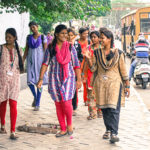#MyCameraIsMyWeapon – In addition to being forced against hijab, there is an effort to promote culture and promote ethics in society. – Masih Alinejad
Instead of begging for our freedom, we decided to get it ourselves.
Women in Iran are opposing forced hijab by choosing to go unveiled in public. When they do, they are sexually harassed by strangers and random men walk up to them, demanding an answer for not wearing a hijab. The women have started video documenting their experiences and the harassment they experience. ‘Now This News’, published a Facebook video on 2nd July 2018 that went viral. The movement against compulsory hijab on Iranian women is known as ‘White Wednesday’ – Many veiled women in Iran also find the compulsory imposition of the veil to be an insult. By taking footages of themselves wearing white, these women can also show their disagreement with compulsion. Masih Alinejad’s Facebook page ‘My Stealthy Freedom’ has generated huge momentum on the cause and has over 100,000 followers on the page.


Today is #WhiteWednesdays in Iran. Let’s feel the wind in my hair. Forcing a woman to wear hijab in order to stop a man from getting provoked is an insult to men as well.
An insult to the sense of every single Iranian man means that you don’t let the wind be intertwined in your hair…impose the veil to all women in the world as soon as their feet reach Iran’s soil so that Iranian men do not attack women. This is more humiliating than being an insult to the woman.
My Stealthy Freedom also raises human rights issues on atrocities against women in Iran, “Welcome to the Islamic Republic, the so-called safest country in the Middle East. Welcome to a place where girls who dress differently, those who dance, the girls who burn in school fires (like Shinabad incident), girls that get raped (as in the case of the girls of Iranshahr) all suffer from injustices. Meanwhile, the culprits of all of these incidents are free… In Iran, child-molesters and acid attackers roam free, but the government would go after people who kiss in public. ”
As an Indian woman, I can relate to the #MyCameraIsMyWeapon and #WhiteWednesdays as movements that seek to eliminate discrimination on the grounds of gender and assert a woman’s right to her body and to a better life by making independent and informed choices for herself. Like Iran, India is high on prevalence of crimes against women. Indian women’s choices are curtailed by patriarchy and guarded by its custodians who apart from men, sadly happen to be women as well. An Indian woman’s social security net exists for those who consent to limiting themselves in the boundaries defined by male society. Any transgression is punished by violating a woman’s body. When women internalize this, they perpetrate patriarchy. Any space outside of patriarchy is not a safe space for an Indian woman.
According to Internet World Stats, Iran reported 69 percent internet users. According to Techrasa website, Iran has maximum internet user base from over 14 Middle Eastern Countries (Bahrain, Iran, Iraq, Israel, Jordan, Kuwait, Lebanon, Oman, Palestine, Qatar, Saudi Arabia, Syria, UAE and Yemen). However, Iran is experiencing state authored dictatorship over internet freedom. As per a website on Internet Censorship in Iran (Open Observatory of Network Interference), ‘News Media’, ‘Human Rights Issues’ and ‘Culture’ are three domains under which all websites pertaining to the aforementioned issues are banned in the country.
As Indians, we are lucky that among the political disturbances, democracy is making attempts to keep itself alive (thanks to watch groups and sensitized citizens). If Iran can take up the issue to eliminate oppression against women; India too, can take cue and do the same.
Towards gender equality and using social media for social change, the Centre for Social Research in association with Facebook has implemented ‘SocialSurfing’ initiative where we engage with the youth on online abuse, employing counter speech to deal with trolls and using social media for social change. Through this process, we have reached out to over 15,000 students from hundreds of colleges across the country. We believe that youth is the hope to transform the country’s destiny.
As an organization that promotes gender equality and gives emphasis on gender transformation, the team of Centre for Social Research has repeatedly spoken on camera against gender based crimes while upholding human rights. The videos of the team members have been disseminated on the organization’s social media handles. Various research studies have predicted that maximum social media content in the future will be in the form of video content and not text and images (as is prevalent today). In tandem with the same, Centre for Social Research uses camera as a tool for awareness generation, much like the Iranian women are using the same for protection and assertion of their rights.
If you have used camera and social media for social change, we would love to hear about it. Please do send across your blog or vlog on writewithus@csrindia.org.




